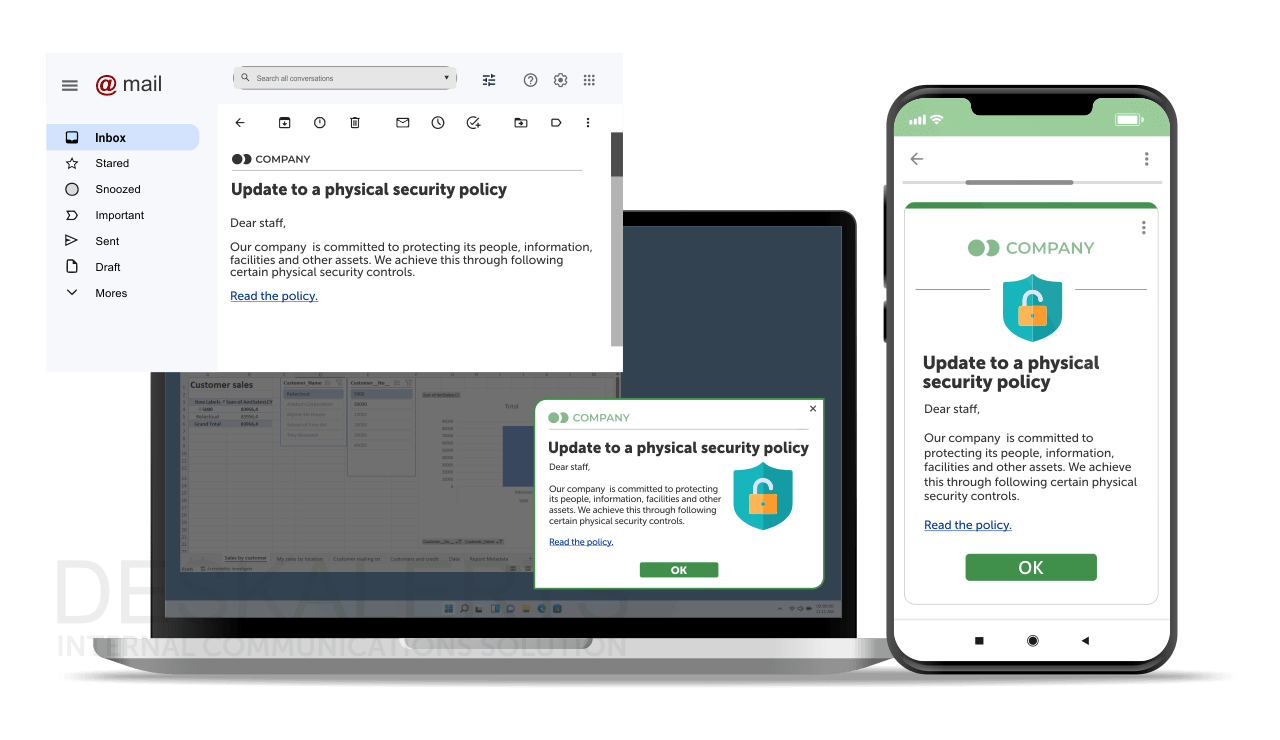
Change in the workplace is difficult for employers and employees alike. Effectively communicating change to employees is necessary in order to ensure that the project, initiative, or another type of change, such as a restructure or merger, in your organization is successful. Without this important element, it could be doomed to fail.
In this article, you'll find core change communication practices and examples for HR or internal communication professionals.
Table of contents
Why communicating change in an organization is important today
Communicating change in an organization: 9 tactics
How to communicate to employees about change in an organization
Communicating change to employees: examples
Why communicating change in an organization is important today
According to a Gartner study, only around 34% of change initiatives pursued by businesses are actually a success.
Part of this can be attributed to a lack of clear, effective, and regular communication. If you don’t provide a convincing argument for change as well as outline the steps people need to take to bring the change about, how can you expect it to succeed?
It is therefore important to have a change communication plan in place that you follow to ensure that you communicate with your employees every step of the way throughout your change process. When you communicate well, you will help to ensure employees are positive about the change, and therefore can help to reduce and mitigate the potential for resistance, ambivalence, or lack of understanding.
When you communicate poorly or not at all, you’re more likely to encounter resistance, a lack of motivation, and a lack of direction that can affect your productivity and the company’s bottom line.
The last few years have seen an enormous amount of change and upheaval in companies around the world, driven in part by the COVID-19 pandemic and the effects it has had on business. This includes shake-ups of entire sectors and the way they function, as well as more rapid implementation of digital transformation projects.
With change almost assured and constant in the modern workplace, you need to have plans, tools, and systems in place so that implementing change in the workplace is successful.
Need to go beyond messaging basics? Learn how to build a full communication strategy with our step-by-step guide.
Communicating change in an organization: 9 key Tactics
So, how to communicate change to employees? When you’re preparing to implement change in your organization, the following strategies for communicating change can assist:
1. Be clear and honest
You need to be up-front and to the point when it comes to communicating change in the workplace. If you try to ‘sugar coat’ bad news or put a positive spin on it that doesn’t really ring true, you will not be able to convince people of the need for change. In fact, you will only end up with mistrust and resentment in the ranks. To this end, it is important to be as transparent as possible with your employees.
You should communicate your change clearly, avoiding jargon, so that employees easily understand what you are doing, and why you are doing it.
2. Communicate regularly
Researchers from McKinsey have found that organizations that communicate regularly during a change initiative are twice as likely to be successful than those that do not.
Your change management communication strategy strategy should factor in regular communications at key intervals in the project – as well as when needed should unforeseen issues arise. Keeping people informed ongoing will help to build trust, keep the change initiative front-of-mind, and help to reinforce the messages you need employees to understand.
3. Communicate using multiple communications channels
In addition to communicating regularly with employees, you should also deploy your information via a range of channels across the organization to both ensure that you are reaching people and to reinforce your messages.
Don’t just rely on email to do the job – email overload might mean that your critical information is unread and buried in employees’ inboxes. Use channels such as pop-up alerts, desktop tickers, screensavers, wallpapers, and digital signage to cater to different information receiving preferences.

4. Provide opportunities for staff to ask questions and give feedback
Consulting with and engaging your employees on change is important if you want to persuade them to embrace it. You need to provide opportunities for employees to ask questions, clarify any points they are confused about and provide feedback about what the change will mean at the coal-face and how it may impact their role and the service they provide to your clients.
There are different ways you can do this, from focus groups and workshops to town hall meetings and surveys.
5. Use visual tools
Create images, such as timelines, countdowns or graphics answering frequently asked questions. You can include these in digital signage, on screensavers or in newsletter content. Your login screen, for example, can be used to count down how many days until a change takes place so employees are reminded every time they log on to their workstations for the day.
6. Keep your messages employee-focussed
It’s important to communicate from the employee’s perspective – which means you should avoid management-speak and avoid being condescending. Employees need to understand what is in it for them, as well as for the organization as a whole. They also need to know exactly what is required of them and how they will personally be affected by change. Failure to do this can result in your change being unsuccessful.
7. Target messages to different audience segments
While you need to communicate from the employee’s perspective, you should also remember that your employees are likely to be a large group who might not always have things in common. For example, if you are merging with another company, your sales team will have different needs in the change process compared to your administrative staff.
When you send your change communications, use audience segmentation so that you don’t overwhelm and overburden all employees with information that may not be relevant to them. At the same time, you can ensure that you are meeting the needs of the employees that need specialist, additional information.
8. Encourage your leaders to model change
When you are undertaking major changes in your organization, you will usually be asking employees to change certain behaviors or work practices in order for the change to be successful. It is therefore critical that your employees see your leadership team modeling the changes that are being required of them – after all if they see that upper management is doing something else they will consider that to be hypocritical and will wonder why they should bother changing.
McKinsey found that transformations are up to five times more likely to be successful when senior leaders in organizations model the behavior changes.
9. Include rewards and recognition
As your change program rolls out, a good way to keep employees engaged with the project and to have reasons to keep communicating about it is to incorporate an element of reward and recognition.
This means you can publicize rewards for employees who take positive approaches towards the change as well as those who are helping to accomplish the change. Each time you reward and recognize these employees you can celebrate your success in a public way.
How to communicate to employees about change in an organization
A popular change management tool is one adapted from a system developed by psychiatrist Elisabeth Kubler-Ross.
Kubler-Ross’s famous grief cycle (7 stages of grief) was developed to assist people with bereavement, but there are many similarities in the way that people react to change. The “Change Curve” tool can be a good place to start when evaluating communicating change to employees and helping employees deal with change in the workplace.
The stages on the Change Curve are:
- Denial
- Shock
- Depression
- Acceptance
- Experimental
- Decision
- Engagement
The model helps you determine the best approach depending on the stage of the curve the employee is at. This includes using clarity, empathy, motivation, capability and knowledge to influence the content and delivery method of your internal change communications.
The tool can work regardless of the change being one that will be negative or positive for employees and can help you to navigate the change from the employees’ perspective.
Communicating change to employees: examples in practice
1. Acknowledging lay-offs
When you’ve had to lay off a lot of staff, those left behind can’t help but notice all the empty seats and desks where their colleagues – often also their friends – used to sit. It can be a funereal atmosphere in the days and weeks that follow, to say the least.
You cannot ignore this elephant in the room. You cannot pretend everything is normal and is business as usual. It’s important that management in a scenario like this acknowledges how people might be feeling, and that they talk through the decisions that led to the lay-offs, and help the staff to go through the Change Curve.
2. Navigating a corporate scandal
In this scenario, an organization might be involved in a scandal that sees it on the front page of newspapers for all the wrong reasons as some senior executives were involved in serious misconduct. The result is that employees are feeling shocked and angry at the good name of the organization they value working for being besmirched in such a public way, and many are considering leaving.
Management in this situation needs to understand the employees are at the beginning of the Change Curve and will need help to navigate their way through the inevitable structural and procedural changes that are required in the organization in order to move forward.
3. Fixing an earlier unsuccessful change attempt
Sometimes change just doesn’t work out the way you hoped and you need to go back to the drawing board. Employees might be burnt out, confused, cynical, and not as receptive to the change as they may otherwise be. In this type of scenario, you need to look at what worked, what didn’t work, and how employees are currently doing their jobs in order to reevaluate the change process and subsequently the communications you deliver.
***
If you want to find out more about how to communicate change to employees in your organization, get in touch with our team of internal communication experts to find out how DeskAlerts can be used to keep your employees informed with critical information.
FAQ:
How do you effectively communicate change to employees?
Effective change communication with employees can be achieved by taking the following approach:
- Be open and honest
- Adopt a top-down communications approach
- Ensure you adequately explain how employees will be affected by the change
- Explain the process in detail
- Provide specific directions about what employees need to do
- Be available to answer questions
- Allow staff to raise any concerns and give feedback
How should you communicate the change of strategy?
When it comes to communicating a change of strategy, you need to share your vision for how the change will work in the organization once it is implemented. This will help your employees to go along on the change journey with you because they’ll be able to better understand it.
What are the 5 types of communication strategies?
There are five different ways of communicating. These are:
- Verbal communication – the act of speaking to others.
- Non-verbal communication – what your body language, facial expressions and so on tell people even if it doesn’t match your words.
- Written communication – the act of writing information for others to read.
- Listening – when you take the time to actively hear what other people have to say.
- Visual communication – the act of communicating via a visual medium such as drawings, photography, graphics, film etc.
Why communication is key to successful change management?
Communication plays a significant role in the change management process. Many change management programs are doomed to fail because communication was inadequate, or non-existent. Good communication builds a strong connection with employees and makes implementing change easier.
 Caroline Duncan
Caroline Duncan








